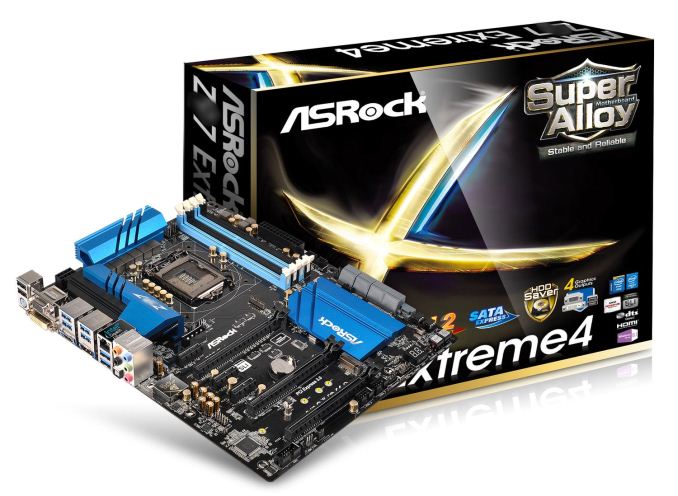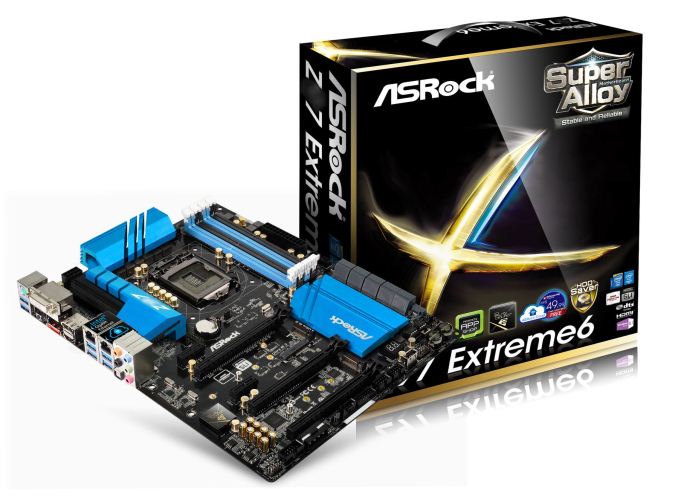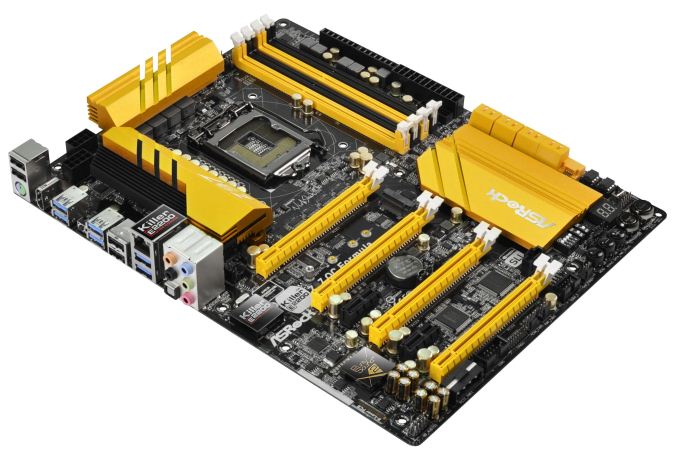Upcoming Intel Based Motherboards from GIGABYTE, ASUS, MSI and ASRock
by Ian Cutress on April 28, 2014 3:30 AM ESTASRock’s New Products
The upcoming range from ASRock uses a striking blend of stand-out colors. Whereas other manufacturers are often seen mixing their colors with black, ASRock is adding an element of vibrancy. Based on the images that we have at our disposal, the mainstream line will start at the Extreme range, move through the Fatal1ty, ITX, and end with the OC Formula at the top.
First up, the Extreme4:
The Extreme4 comes in blue with what looks like 9 SATA ports and an M.2 slot. We see a USB 3.0 header, two removable BIOS chips, a TPM header, ‘Purity Sound 2’ (looks like an upgraded audio package) and Intel Ethernet. I am a little disappointed to see a 4-pin Molex connector in the middle of the board for additional PCIe power though.
Then the Extreme6:
Here are dual Intel NICs, along with what looks like 11 SATA ports, a mini-PCIe slot and two M.2 slots. One of these slots is called ‘Ultra M.2’, with the words ‘PCIe Gen3 x4’ next to it, suggesting that they are implementing an x4 M.2 slot for the faster devices. None of them are actually on the market yet. The Extreme6 has a slightly better positioning for the PCIe power 4-pin molex connector, but I would still prefer a SATA power or 6-pin PCIe.
Moving onto mini-ITX, the ITX/ac:
So while the box says M.2, there is no visible M.2 on the top of the motherboard. Given past experience with ASRock motherboards, they have probably relocated it to the bottom. However on the top they do have a SATA Express port and a mini-PCIe. These are unfortunately just inside the DRAM slots, meaning cables will have to go over large GPUs or memory to be equipped. The WiFi module is a 2T2R 802.11ac solution, and is combined with an Intel NIC. The 8-pin CPU power connector is in the middle of the motherboard, making cable routing a little frustrating.
For gamers, ASRock has the Fatal1ty Killer:
ASRock leaves its Fatal1ty range for features like the Atheros Killer E2200 NIC. The motherboard has four SATA ports, a SATA Express port and an M.2 port. We also get Purity Sound 2 here, which I would guess remains an ALC1150 codec underneath with improved filtering. The motherboard offers a single USB 3.0 header, and the rear IO has the USB gaming port from the previous Fatal1ty motherboard iterations.
Finally at the high end is the OC Formula:
The yellow for the OC Formula has changed slightly, especially on the heatsinks where it is a little more yellow. On the OC Formula ASRock has equipped it with on-the-fly adjustment buttons and voltage check points, along with more power phases. The quad PCIe layout seems devoid of a PLX chip, suggesting an x8/x4/x4 + x4 layout similar to the old Z87 OC Formula. Interesting enough there is a header onboard labeled ‘TB1’ suggesting Thunderbolt support. The motherboard also seems to have Purity Sound 2, a Killer E2200 NIC, an M.2 slot, nine SATA ports, a USB 3.0 header and a 4-pin molex for PCIe power.





















58 Comments
View All Comments
Antronman - Monday, April 28, 2014 - link
Nope.With the same chip, on a Gigabyte, MSI, ASRock, and RoG mobo, the chip will always be able to pull off lower voltage on the same OC on an RoG.
willis936 - Monday, April 28, 2014 - link
You're going to have to cite some threads with some actual numbers and caps or else you're just blowing smoke.Achaios - Monday, April 28, 2014 - link
Looks like someone is -shamelessly- copying ASUS ROG. I am a member at OVERCLOCK.NET, and almost every member who has got his rig published there owns an ASUS Maximus VI Hero ROG board, myself included. We don't need to see sales figures to understand how well the Gigabyte Z87 series of boards with those pathetic colour schemes, emphasis on useless sound chips, and contempt for overclockers and enthusiasts has sold even with prices as much as 30% cheaper than ASUS.nevertell - Monday, April 28, 2014 - link
Don't call the sound codecs useless. Although, if one were serious about their audio quality, they'd have a discrete DAC, but nevermind.Creig - Monday, April 28, 2014 - link
Looks like someone is -really- taking their ASUS purchase too seriously. I've used Gigabyte motherboards in the past and found them to overclock decently, to be rock-solid in every day usage and they weren't overly expensive considering all the features they offered. I would have no problems purchasing either an ASUS or Gigabyte motherboard for my next upgrade.The_Assimilator - Monday, April 28, 2014 - link
Looks like MSI is betting that SATA Express will fall flat, at least this generation. If that means their boards are cheaper than the competition's, could be a big win for them.It's disappointing that you still have to go for high-end expensive motherboards to get 2x USB 3 internal headers. Hopefully Intel will give out more USB 3 ports (minimum 10, please) in the Skylake chipset.
Hrafn - Thursday, May 1, 2014 - link
I must admit I'm having a hard time seeing SATA Express's niche. Given the availability of multiple SATA3 ports on most MBs SATA-backward compatibility would not seem to be a major selling point. M2 seems ideal for small-but-fast system drives and full PCIE cards for those requiring maximum size and speed (which generally go together on SSDs). Is there really a potential market for PCIE 2.5" drives, particularly given SATA Express's complex cabling?rjlew88 - Monday, April 28, 2014 - link
Love the Z_7 boards! The only one clearly indicated as "Z97" is the pic for IMG_1656.JPG. I hope you continue to bring us the comps between Z67, Z77, and Z87 with the new Z97 for reference. Thanks. Long live Sandy and Ivy!!cm2187 - Monday, April 28, 2014 - link
What about that 32GB RAM limit? Will intel increase it?peterfares - Monday, April 28, 2014 - link
Probably not soon, they want you to buy server hardware if you want more than 32GB. And what do you really need more than 32GB for?